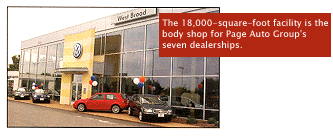
Shop manager Stuart Hendrick knew that mobile repair companies were putting a dent in shop profits. The question was: What could he do about it?
As the manager of the body shop for Page Auto Group’s seven dealerships (two Honda, two Toyota, Dodge, Volkswagen and Audi), Hendrick couldn’t help but notice how many jobs West Broad Collision Center was losing to local mobile repair companies like Colors On Parade and Ultra Color. And he didn’t like it.
“Our dealers were using mobile repair guys daily,” says Hendrick. “That’s a lot. They used them a lot for spotting used cars on the lot. We were getting small jobs from our dealerships only if a mobile guy couldn’t do it. And for us to do a scratch on a bumper, we’re talking a three-day job. One day you take the bumper off, you repair it and prime it and then it sets overnight. The next day they paint it, and the next day it gets put back on. That was the normal procedure.”
No wonder the mobile guys were getting the work.
But … if Hendrick could turn those small jobs around in minutes, rather than hours or days, West Broad Collision Center could become more competitive.
A Bright Idea
It all came together (a light bulb went off in Hendrick’s head, so to speak) when a sales rep from his paint company stopped in for a visit.
“One day a sales rep … came by here and showed me a new ultraviolet clearcoat system,” says Hendrick. “He did a demo on it and it worked great – and the first thing that came to my mind was, ‘Hey, we can compete with these mobile repair guys now.’ ”
And so Hendrick’s version of the “fast lane” was born.
“Different people have different ideas about the concept of a ‘fast lane,’ ” says Hendrick. “In some shops, their fast lane is getting cars in and out quickly for insurers so they’ll send the shop more work. That’s not our fast lane.
“Our fast-lane repair is always a repair that you can keep in a 12-inch diameter because the ultraviolet clearcoat cures by the ultraviolet lamp – and the lamp cures a 12-inch by 12-inch area. In the right conditions, you can get a car out in an hour and a half.”
Changing Lanes
To redefine the fast-lane concept his way, Hendrick began by purchasing a UV curing light and training one of his technicians on the new piece of equipment. He set the tech up in a 30-foot by 25-foot stall and then launched the fast lane in May 2005.
“I’ve got a stall out in the body shop for my fast-lane tech where he can fix a bumper or what have you, and then he takes it over to one of the extra paint booths we have and sprays it,” says Hendrick. “He hops around the shop and doesn’t have a specific place he works; he’s utilizing all the equipment around the shop.”
So how does the “fast lane” work?
“Cars come through the fast lane just like any other job. Somebody from one of our dealerships will contact us and say, ‘Hey, I’ve got a scratch on a new car,’ or the service department will call me and say, ‘Hey, we just nicked a customer’s car in the shop. We need to get it out quick.’ So I write up something and send it out to my fast-lane repair tech and he takes care of it.”
Hendrick says he’s confident that once word gets around about the service, he’ll see the volume of fast-lane work increase. And because all the other dealerships in Richmond also use mobile repair services, there’s a potentially large market to tap into.
In its first three months, Hendrick says the fast lane averaged eight jobs per week. His goal: to eventually do six or seven jobs a day. For now though, Hendrick’s just happy to have the business he has.
“The body shop’s making money,” says Hendrick. “And we’re saving all of our dealerships a lot of money by keeping stuff in-house – and doing better work.”
Writer Bob Bissler is managing editor of BodyShop Business.













